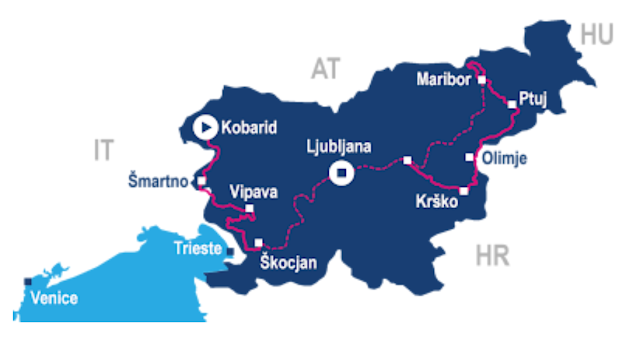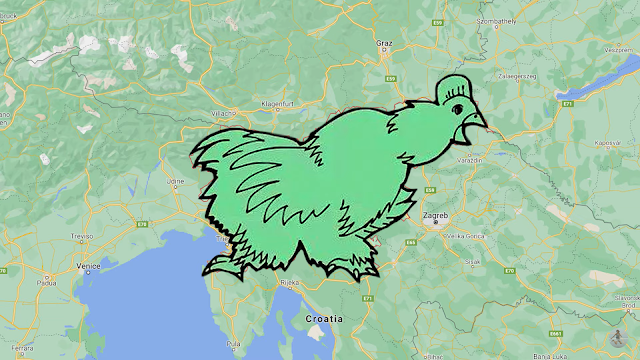Louise Erdrich
.png) |
| Šmartno, where vineyards
dominate the landscape. In every direction, grapevines carefully hug fields as far as the eye can see, dropping behind the horizon. |
I first saw Šmartno’s fortified Medieval village (called an eagle’s nest by poet A. Gradnik) from the Gonjače viewing tower (more on that below) a stone's throw from there. To view this hamlet within the context of all those meadows, vineyards, cherry orchards, figs and olive groves is breathtaking. Once a military fort, today, a somewhat romantic place, where it seems that time stopped long ago, it is a Medieval village with charming Mediterranean character.
 |
| Map of our guided tour. Full line by bike, dotted line by train We covered the West side first, then the East side |
 |
| A bit of fun, the country of Slovenia is roughly in the shape of a chicken |
This hilltop village, surrounded by defense walls with watchtowers, is first mentioned in 1317. There are no historical records of the origin of the defense walls, but it is believed that the walls were probably erected on the remains of a Roman bastion in the period of the wars between the Habsburgs and the Venetians during 1507-1519.
Šmartno, served as a fortified hamlet, built around the church of St. Martin, during the times of the Turkish raids in the 15th and 16th century. It became a strategically important point on the border between Venice and Austria. Šmartno was actually part of a larger system of fortifications, which included other villages. Šmartno was used as a fortification until the middle of the 18th century when danger of military attacks from the Venetians ceased.
Walking this tiny village takes a mere thirty minutes and it feels like you are in a small labyrinth of sort with only two public ways out. Other than in your own thoughts, you can’t get lost in this very small place.
The village of Šmartno lies in the heart of this sun-kissed wine region of Brda. Its strategic position on the top of the hill offers a wonderful view from the Alps to the Adriatic sea. The old village walls, narrow streets and defense towers give this village a unique charm.
In the pre-Roman period, wine-growing began in this area because of the excellent weather, unique climate, which has both powerful Alpine and mild Mediterranean influences, as well as mineral and rich soil. It was an established wine-growing area as far back as 181 BCE. Many ancient amphoras found in this area show how vital the village and its environment were as a place where wine was grown. Yet it is little known.Ever since the earthquake of 1976 and until now Šmartno has enjoyed extensive and needed renovation works.
Unfortunately, a large part of this region had been hit by damaging hail the season I visited so many fields of grapes were not being picked, grapes just slowly drying on the vines. I watched a few crews and father/son teams clean up the rows between the vines, hoping for a better season next year.
.jpg) |
| Šmartno, where each soffit has a different pattern |
.jpg) |
| Šmartno, where each soffit has a different pattern |
.jpg) |
| Šmartno, where each soffit has a different pattern |
.jpg) |
| Šmartno, where each soffit has a different pattern |
 |
| Solkan Bridge |
They used 4,533 ashlar (square-cut) blocks in its construction. The Solkan bridge holds this record because later construction technology used reinforced concrete to build bridges.
The first train from Vienna arrived at the port of Trieste in 1906. The bridge was demolished during WWI. However, they were able to rebuild it following the original plans (with the minor difference of using four sub-arches instead of the original five, and a slightly different curvature) and is still serving its purpose to date.
Then the bridge was spared. During WW2, it suffered only minimal damage from bomb attacks. On August 10, 1944, bombs did not hit the bridge; on March 15, 1945, the bomb that hit the bridge did not explode.
In 1985, the Solkan Bridge was acknowledged as a technical monument and thus enjoy special protection.
.jpg) |
| Gonjače viewing tower Dedicated to the 315 local citizens who gave their lives in WWII Central point of the Brda Region, 75 feet (23m) high with 144 stairs |
 |
| Bronze plaque at bottom of viewing tower, sculpted by Janez Boljka 'To the sons of Brda and Benečija, the faithful guardians of our language.' France Bevk. |
.jpg) |
| First floor of my hotel suite at the Al Di La Hotel Mixture of modern and ancient - beautiful |
.jpg) |
| Stairway with hearts |
.jpg) |
| Unfortunately, most grapes had been heavily damaged by hail this season No one would be picking this failed crop |
.jpg) |
| Village of Slap - Vipava Valley Home of the first school of viticulture and pomology in Slovenia (1873) |
.jpg) |
| Village of Slap, kids copying their parents, handling agricultural products |
Village of Slap
Today, viticulture is the most important industry in this
village of only 400 souls. It was as early as 1689 that
Valvasor wrote that '...the tears of the vineyards in Slap taste the sweetest'. Zêlen and Pinela are among the oldest
indigenous species of vine grown here.
To this day, the village is renowned primarily for its high-quality
wines.
.jpg) |
| Hotel Majerija, built around 1700 Motto: ‘Aroma Burje in Sonca’, Aroma of the wind and the sun |
The initial house was built around the year 1700 containing the usual (kitchen, outhouse, bedrooms) as well as a ‘faladur’ (an old dialect word for an antechamber to the cellar where people socialized and drank), a room for grape/wine processing, a hay shed, a chicken coop, a granary, a stone vaulted cellar, and a stable.
Matej and his wife Nataša finally bought this farmhouse, long dreamed about but without the necessary funds, in 1994 when he was still working as a chef in renowned restaurants and teaching at a hotel school in Trieste. She was also a teacher.
It took them twelve years to slowly give shape to their dream and transform that abandoned place into what it is today. Since Majerija is a protected cultural property surrounded by land used for cultivation, the strict rules made it that the only possibility to make something special was to create a cozy, modern and innovative underground accommodation with completely natural materials. Of consideration was also the view.
Under the herb garden, you enter a simple room. Each of the ten rooms is named after an herb. I chose Rosemary but it could’ve been Lavender, Hyssop, Basil or… A gigantic painting of the said herb covers the far wall of the room. Lavender is of course painted in that color and so are the others, the Rosemary room was painted in that darkish green.
Due to the good use of light, you do not have the feeling of being underground at all. Skylights ensure you’re not starved of natural light, and the temperature is a constant 63F (17C).
Kudo to Matej and Nataša for their perseverance and amazing creativity while respecting the ancient feel of this place.
.jpg) |
| My Rosemary room All rooms underground to preserve the look and feel of this historic building and of the surrounding valley |
 |
| Hotel's restaurant = Au gratin beetroot pocket, on top of pasta, sprinkled with pine nuts and a sprig of fresh sage Recipient of the Gault & Millau rating of 15.5/20 in 2023 |
.jpg) |
| The hotel also has its own ancient wine cave Matej, the owner, recounting its history |
.jpg) |
| View of the nearby valley |
.jpg) |
| Beautiful anywhere you look |
'The spring fills the air with the sweet scent of cherries and apricots, the summer offers plump peaches and the retreat of the cool wine cellar, the autumn brings persimmons, homemade delights. The valley with its long vegetation period bears a variety of Mediterranean fruits, and its terraced slopes cradle splendid vineyards and orchards. The sunny sites across the Vipava Hills provide the skilled and dedicated winegrowers of the land with perfect conditions for growing as many as 25 different grape varieties.'
www.vipavskadolina.si
Nearly all the routes provide breathtaking views, in clear
weather reaching all the way to the sea.
The wind here is called the Bora – it is so strong that
people add rocks on top of the red tiles on their roofs. They also secure the tiles with cement instead
of just nailing them down.
Vipava has numerous natural and cultural sites. It’s a place dominated by water and boasts as
many as 25 bridges. e As a bit of a stung, we rode for a few seconds on one of those bridges. Just to
say we did.
In 1500 it was visited by Leonardo da Vinci, who studied the
possibilities of damming the Vipava River as a defense against the Turks, thankfully he wasn’t successful.
.jpg) |
| First time viewing Šmartno from the Gonjače Tower Can't miss St. Martin's Church with its heavily built belltower near its center |

.jpg)
No comments:
Post a Comment
We are always happy to hear from you but at times it may take a while to get a reply - all depends if we have access to the internet.